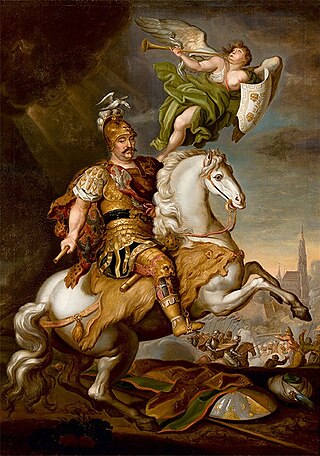Top Qs
Timeline
Chat
Perspective
House of Sobieski
Polish noble family From Wikipedia, the free encyclopedia
Remove ads
The House of Sobieski (plural: Sobiescy, feminine form: Sobieska) was a prominent magnate family of Polish nobility in the 16th and 17th centuries, from which the King of Poland and Grand Duke of Lithuania Jan III Sobieski originated. The family used the Janina coat of arms.
Remove ads
History
According to the family's legend, it traced its lineage to a Polish duke, Leszek II the Black. Another family legend said that they were the descendants of Duke Sobiesław, the son of Leszko III, a legendary ruler of the Popielids dynasty. The family reached the height of its power and importance in the late 16th and 17th centuries, when one of its members was elected King of Poland: John III Sobieski (Jan III Sobieski). The last male member of the branch of the family that began with John's grandfather, Marek Sobieski, in the 16th century was Jakub Ludwik Sobieski (1667–1737).
According to an alternative version provided by the 18th century chronicle writer Samiilo Velychko, Sobieskis originated from local boyar Sobko from Galicia (Halych region) who converted into the Roman Catholicism.[7]
Remove ads
Coat of arms
The Sobieski family used the Janina coat of arms, and their motto was Vel cum hoc, vel super hoc.




- Coat of Arms of John III Sobieski as the King of Poland
- Portrayal of Sobieski's royal crown, Gdańsk.
Remove ads
Notable members
Remove ads
Palaces
- St. Lawrence's Church in Żółkiew. Mausoleum of the Żółkiewski and Sobieski family
- Wilanów Palace, Warsaw
- Wilanów Palace, Warsaw
Famous descendants
Summarize
Perspective
Among the descendants of John III Sobieski were one Holy Roman Emperor (simultaneously one King of Bohemia and one King of Germany), seven Kings of Saxony (simultaneously one Duke of Warsaw), one King of Bavaria, two Kings of Italy (simultaneously one Emperor of Ethiopia and one King of the Albanians), one Tsar of Bulgaria, one Emperor of Austria (simultaneously one King of Hungary), one Queen consort of Spain and one titular Queen consort of England, Ireland and Scotland.
Tree
- John III Sobieski, married Marie Casimire Louise de La Grange d'Arquien
- Theresa Kunegunda Sobieska, married Maximilian II Emanuel, Elector of Bavaria
- Charles VII, Holy Roman Emperor



- Duchess Maria Antonia of Bavaria
- Charles VII, Holy Roman Emperor
- James Louis Sobieski
- Maria Clementina Sobieska (titular Queen consort of England, Ireland and Scotland)
- Theresa Kunegunda Sobieska, married Maximilian II Emanuel, Elector of Bavaria
Remove ads
References
External links
Wikiwand - on
Seamless Wikipedia browsing. On steroids.
Remove ads




















